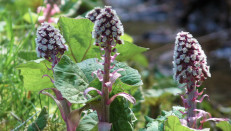

Butterbur or Bog rhubarb (Petasites hybridus).
Photo: Dr. Günter Matzke-Hajek
Compared to animals and fungi, plants do not belong to the most species-rich groups of organisms. However, they account for a large proportion of the Earth’s biomass and are therefore a conspicuous component of our environment. The most important biological feature that most plants have in common is their ability to use sunlight to produce energy by means of photosynthesis.
In addition to the Red Lists of ferns and fern allies, flowering plants and conifers (4,305 species, sub-species, varities) and mosses (1,195 species, sub-species, varities), five Red Lists analyse the level of threat to several important groups of algae that comprise 3,515 species, sub-species, varities: limnic red and brown algae, yellow-green algae, limnic diatoms, desmids and marine macro algae.